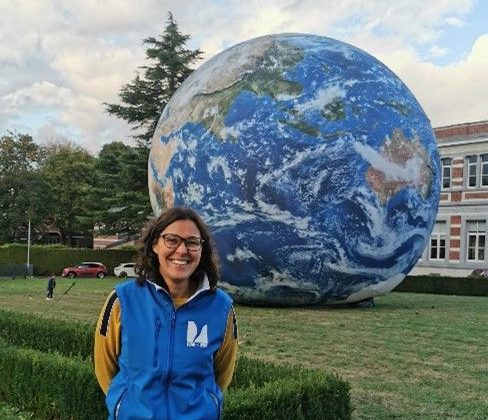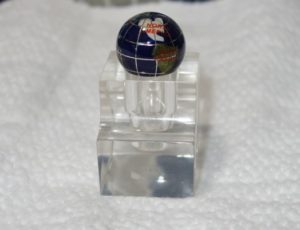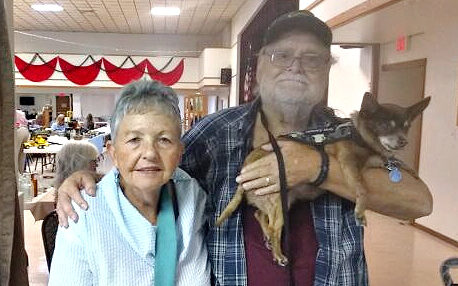
We learned recently from Wendy Leyn, our colleague and friend in Zandvoorde (Zonnebeke), West Flanders, Belgium that “marble minds” really do think alike. He recently saw this gigantic marble online and he wrote to Professor Lesley De Cruz[1], who is pictured above.
Wendy: “I saw a nice photo of you with a ‘giant marble’ in the background. Could you tell me where that photo was taken and whether we could possibly use that photo as an illustration for a marble magazine?”
Professor De Cruz was most gracious in her response. She said that we could use the photograph and also told us where it was taken: “That photo was taken at the ‘space pole’[2] in Uccle, the site where the Observatory, the Royal Meteorological Institute of Belgium and the Royal Belgian Institute for Space Aeronomy (BIRA-IASB) are located.” Uccle (Ukkle) is a municipality of the Belgium Brussels-Capital Region.
It’s a very nice photo, and, like Wendy, the first thing we thought of when we saw it was a giant marble! And, the photo reminded us of a “earth marble” which we were gifted years ago.
In August 2011 we were on an antiquing trip to Indiana with Larry’s sister, Lynn G. Howell, and his brother in law. In Nashville, Indiana, we visited The Crystal Source shop. We found a few cloisonné marbles like the one in the photograph to the right, and Lynn gifted us with one. A cloisonné marble was one of Lynn’s goals for the trip.

As you can see it is a gorgeous marble. And, while we could not imagine it at the time, it is the only cloisonné marble that any of us have ever seen!
The marble is just larger than ¾” and just smaller than 13/16”. Stanley A. Block in Marbles Beyond Glass (Atglen, PA: Schiffer Publishing Ltd., 2006) writes on page 141 that “Cloisonné is enamelware in which the decoration is formed by different colors of enamel, separated by thin strips of metal set on edge. With marbles, these are usually hollow balls not meant to be played with, as they are very fragile. Very few early examples exist.”
Ours is modern. But you can see the bright silver wires which represent lines of latitude and longitude. Of course, most of the enamel on the marble is blue, but the continents are shades of green, brown, and white. There is the appearance in places of mother of pearl or shell. The continent names are spelled out in red. It is a beautiful work of art.
As is the earth itself. This is the story of something which reminds us of marbles. You might have seen any number of things which reminded you of marbles. Take a moment and click the Contact Us button and tell us about your experiences and maybe send us a photo which we can share with others. We are anxious to see what you can find.
- She serves at ETRO, Electronics and Informatics Department, Vrije Universiteit Brussel www.etrovub.be / www.vub.be Royal Meteorological Institute of Belgium www.meteo.be / Weather app ↑
- https://spacepole.be/en/ 3/30/2024 ↑

